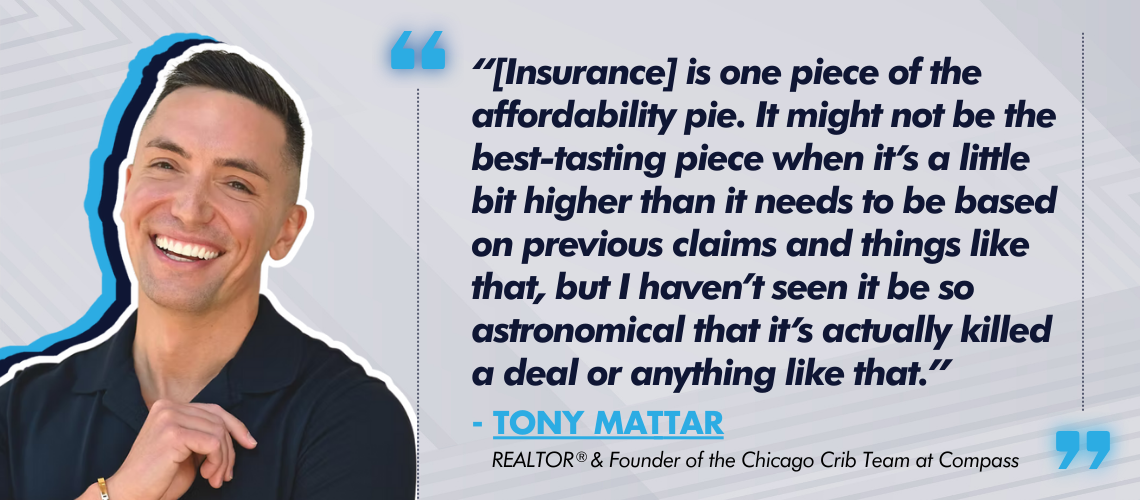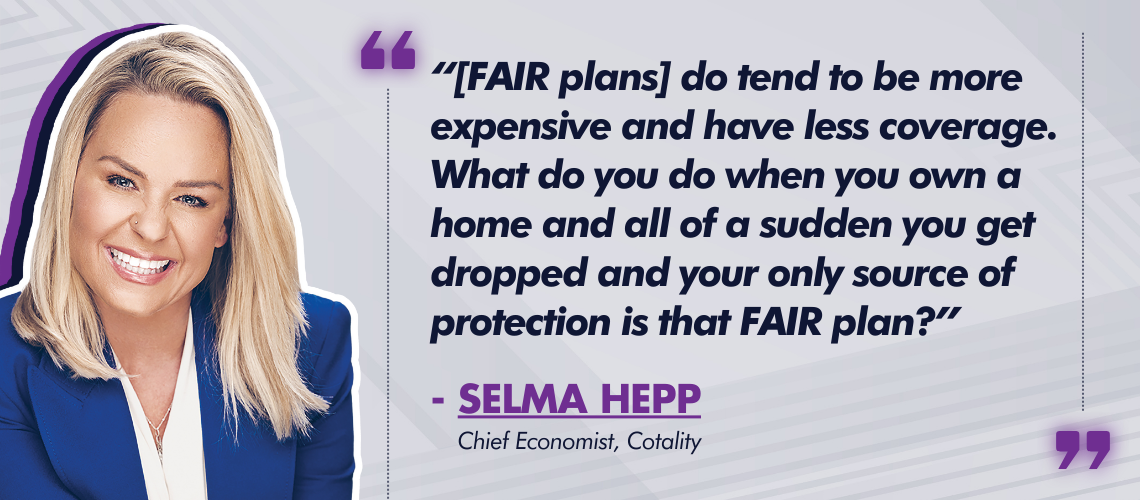Homeowners’ insurance costs have been rising throughout the U.S., and one of the root causes of those jumping premiums has been making headlines in recent years: natural disasters.
The damage inflicted on neighborhoods by recent climate-related disasters—from Hurricane Helene’s destruction in Asheville, North Carolina, to the wildfires that ravaged Los Angeles back in January—means that homeowners in those areas have had to lean on insurance policies. With more and more homeowners needing their insurance to rebuild or repair disaster-damaged homes, insurance companies have become more restrictive about their policies.
The National Association of REALTORS® (NAR), citing a study by Insurify, reported in May 2024 that the average home insurance rate is $2,377 annually. More than eight states were projected to see double-digit annual rate increases, topped by Louisiana’s projected annual rate increase of 23%, or $7,809 total.

Moreover, a recent report from LendingTree has found 25% of home insurance policyholders did not have their policies renewed, up from 19% last year. 50% of policyholders fear cancellation, almost twice as high as the 26% who did in 2024.
As of this moment, migration trends do not indicate that homebuyers are steering clear of climate-risky environments. However, some private insurers are pulling back altogether from certain markets, in particular, Southern states that are vulnerable to hurricanes, and in the West, where wildfires have become more threatening.
REALTORS® confirm they’re seeing the effects of higher home insurance premiums factor into a greater number of transactions. Different weather events—floods, wildfires, storms—lead back to the same effect of escalating premiums.
For instance, Lisa Nguyen—a team leader with RE/MAX Professionals in Lakewood, Colorado—notes that hail storms back in 2024 “caused a lot of insurance carriers to go out of business or raise their premiums.” Hail, which can leave its greatest damage to a home’s roof, can cause a ripple for a homeowners’ insurance costs.
“Another thing that affects the insurance premium is HOAs (homeowners associations) because they depend on insurance policies to cover the damage caused on the roofs, so when the insurance isn’t covering it in Colorado, they tack on the assessment to all current homeowners,” Nguyen explains.
Condo HOA fees are also on the rise in Florida, according to a 2024 report by Redfin, and insurance premiums are a key factor pushing them up.
Alan Gabay, a Florida-based broker associate and director of luxury sales at SERHANT, has previously said that buyer agents and clients should review an HOA’s (or a condo association’s) financial records and recent meeting-minute transcripts in order to better prepare for the kinds of costs they may be facing.
As for Nguyen’s local market, Colorado has experienced noticeably high homeowner-insurance premium rises in recent years, with a report from the Colorado Department of Regulatory Agencies showing that premiums rose by 51.7% between 2019 and 2022.
“In Colorado, depending on where you’re buying, there’s some insurance carriers that won’t even write policies in certain mountain areas,” says Nguyen.
“Prices have risen, interest rates are double what they used to be, and when you tack on insurance premiums, it has completely pushed some people out of the market,” she adds, noting that buyer agent commission-structure rule changes mean that buyers can face higher home prices in the form of paying commission rates. That, in turn, can eat into said buyer’s ability to afford insurance.
“(T)hey can’t take (insurance costs) on if they end up having to pay for their agent’s commission. It’s just not something they can afford,” explains Nguyen.

Another upward driver of insurance premiums is builder-defect laws—laws that hold builders, not homeowners, liable for defects in a home (the statute of limitations for homebuilders varies by state). Nguyen argues that current laws make it “easy for everybody to file lawsuits against these developers for every single defect,” driving up the insurance premiums builders face and creating another hurdle to the development of new housing stock.
In particular, insurance can drive up the cost of existing homes that have issued prior claims.
“Even if those claims were made by a previous owner and not necessarily my client who’s trying to purchase the unit, it can be difficult to find a carrier that will cover a buyer for homeowners insurance on a unit that’s had previous claims,” says Tony Mattar, founder of the Chicago Crib Team at Compass. “I never saw that for the first eight or nine years of my career, but I’ve started to see it happen more often within the past one or two years.”
Mattar has made sure he’s educating both past and present clients about this trend, advising them to be “super-judicious” about filing a homeowners insurance claim.
“Not only can it affect their ability to get homeowners insurance in the future, but it can also make it difficult for the property to be covered for a new buyer,” he adds.
Is the answer to move to areas with low probability of disaster, in hopes of resulting lower premiums? It may not be that simple.
In fact, according to Hunter Powell, CEO of Colorado-based managed repair experience company Accuserve Solutions, Inc. (which manages a network of restoration contractors that services homeowners who’ve filed an insurance claim after damage to their home), it’s likely unfeasible that homebuyers can or should decide where to move based on low insurance.
“The truth of the matter is that these carriers have to balance the book of business across the entire country,” says Powell. “Most of the big guys like State Farm write one in four policies in this country, maybe one in five, and they have to make money across their entire system. So everyone’s bearing the brunt of these weather events that are becoming more prevalent geographically and more frequent in all these areas. I don’t think you can really search for a home based on low insurance anymore. I’m just not sure it exists.”
Is the answer instead to opt out of insurance altogether, gambling that the costs of that decision won’t be even greater in the future? The aforementioned LendingTree survey found that 24% of policyholders don’t think home insurance is worth it.
However, the answer will depend on the assets the homeowner has.
As Powell says, mortgages typically come with a requirement for homeowners insurance. Thus, if your client is taking out a mortgage, they’ll likely need to take out an insurance policy as well. If you’re working with a client who is able to pay cash, the mortgage issue is null.
Mattar also says he hasn’t seen a transaction fall through outright because of insurance costs or a buyer deciding not to pay them.
“(Insurance) is one piece of the affordability pie,” says Mattar. “It might not be the best-tasting piece when it’s a little bit higher than it needs to be based on previous claims and things like that, but I haven’t seen it be so astronomical that it’s actually killed a deal or anything like that.”
Cotality (formerly CoreLogic) Chief Economist Dr. Selma Hepp comes to similar conclusions as Powell when it comes to foregoing homeowners insurance.
“If you buy with cash, you’re basically taking that risk on your own, and it’s just a matter of risk appetite,” says Hepp. “Some people will say, ‘Okay, I want to live in this beautiful beach house, and I’m willing to take this risk,’ but for regular folks who buy homes with (a) mortgage, this is where they may now research in advance of making that offer—how much this insurance premium is going to be and putting that into their calculation before they make an offer on a home.”
In assessing insurance, homeowners should look for not only monthly premiums but what the payout might be if they file a claim. Powell says that insurance carriers, in order to create “a sustainable loss ratio,” have been adjusting policies from a replacement-cost value (meaning the claim will pay for the cost of repair) to actual cash value (meaning the claim will pay the exact cash value of the damaged part, depreciation and all).

“Reading a policy is not easy to understand, and I think homeowners have a knowledge gap there,” says Powell. “They don’t have a commensurate savings amount built up to support the knowledge gap in what may or may not be a large economic out-of-pocket (repair cost).”
Knowing that your clients might struggle to grasp the ins and outs of their insurance policy is another reason for buyer agents to educate themselves and have a trusted insurance agent in their sphere.
“We’re recommending (our clients) shop around, to see who will actually even write policy, to just compare rates,” says Nguyen. “I’ve done that myself on my own properties, and there have been companies that have been completely different in the rates, so I think it depends on how big the company is. Some of these policies I’m getting aren’t even looking remotely the same.”
LendingTree reported that 58% of policyholders have shopped around for home insurance (successful switchers saved an annual average of $1,034), while 34% reduced their coverage.
Still, shopping around doesn’t necessarily mean a buyer will get their ideal deal. Mattar says that insurance costs typically only become apparent when a transaction is already underway.
“If you end up in one of these situations where you’re already in bed with a contract in hand and you’re starting to determine that the most competitive carriers won’t cover the unit, then you’re left with—best case scenario—less options, or worst case scenario, a single option that sort of has you in a chokehold where they can charge you whatever they want,” explains Matter. “Then you have to make a decision about whether or not you want to proceed, or if this is going to be a sticking point from an affordability standpoint.”
While insurance costs from private carriers have climbed, state governments have created “last-resort” options for homeowners: Fair Access to Insurance Requirements (FAIR) plans, or state-mandated insurance plans—instituted by state governments but backed and run by private insurers that operate in the state. The purpose of FAIR plans is to assist homeowners who can’t get insurance through plans on the regular market, such as those who live in high-risk disaster areas.
In 2018, California also passed a law to bar insurance companies from canceling existing insurance plans in areas when hit by weather disasters—the law was most recently called into effect due to the LA wildfires.
No matter what state you’re in, experts suggest looking into the public insurance fallbacks that local governments offer. But are FAIR plans the future? Powell says he expects Accuserve will work with them eventually.
“We’ve worked exclusively in the past with the private insurance carriers, but I would say working with the FAIR plans is absolutely in our future. And I think, again, as the government enters this sector, we need to continue to push efficiency and innovation,” says Powell. However, he also maintains that FAIR plans are not a panacea for rising costs in the private insurance sector.
Powell specifically cites a recent $1 billion bailout to the California FAIR Plan, which did not have sufficient funds to cover all claims filmed, and so is collecting the funds from local insurance carriers. Reporting says this could see those carriers pass costs onto their policy holders.
“That’s not a sustainable business model either, and that’s not going to attract more private competition in California. It’s going to dissuade the competition,” he says.
Hepp notes that FAIR plans come with challenges on the consumer side as well.
“(FAIR plans) do tend to be more expensive and have less coverage, so again, you’re taking a little bit more risk, but what do you do? What do you do when you own a home and all of a sudden you get dropped and your only source of protection is that FAIR plan?” asks Hepp. “I think both Florida and California state plans have exploded because so many people went on them, and now those states are trying to work with the insurance industry to bring insurers back.”
Powell believes there is a “trust gap” among insurers, contractors and consumers that has built up over the past decades—and bridging that gap, he says, is the way to create the most efficient insurance industry.



